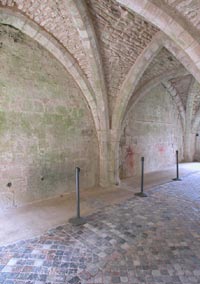 |
 |
 |
 |
 |
 |
 |
|
Fountains Abbey: History
Fountains Abbey: Buildings
|
The warming-house lay in the southern range, between the day-room and refectory, and was so named as a large fire burned here during the day from 1 November until Good Friday. Accordingly, this was one of the warmest spots in the precinct. The warming house at Fountains was part of Robert of Pipewell’s building programme, and was completed in the late twelfth century. It had two large fireplaces in the east wall, and fuel was stored in a yard that lay to the south of the warming house. Wood from the outer court was brought to the store via a bridge, rather than through the cloister, to avoid disrupting monastic life.(56) Whilst
the warming-house was used by the monks to warm themselves, the
heat here meant that this was an appropriate place for scribes
to prepare ink for their parchment and where shoes could be greased.
Bloodletting, a restorative treatment that each monk received
four times a year, was also carried out here. It has been suggested that in the sixteenth century the warming house was used to store cheese.(57) The room above the warming house probably served as the muniment room, where important documents could be safely stored in a fireproof and damp-free environment. This summer the muniment room at Fountains will be open to visitors for the first time, who will be able to view the restoration work and the medieval tiled floor. |

